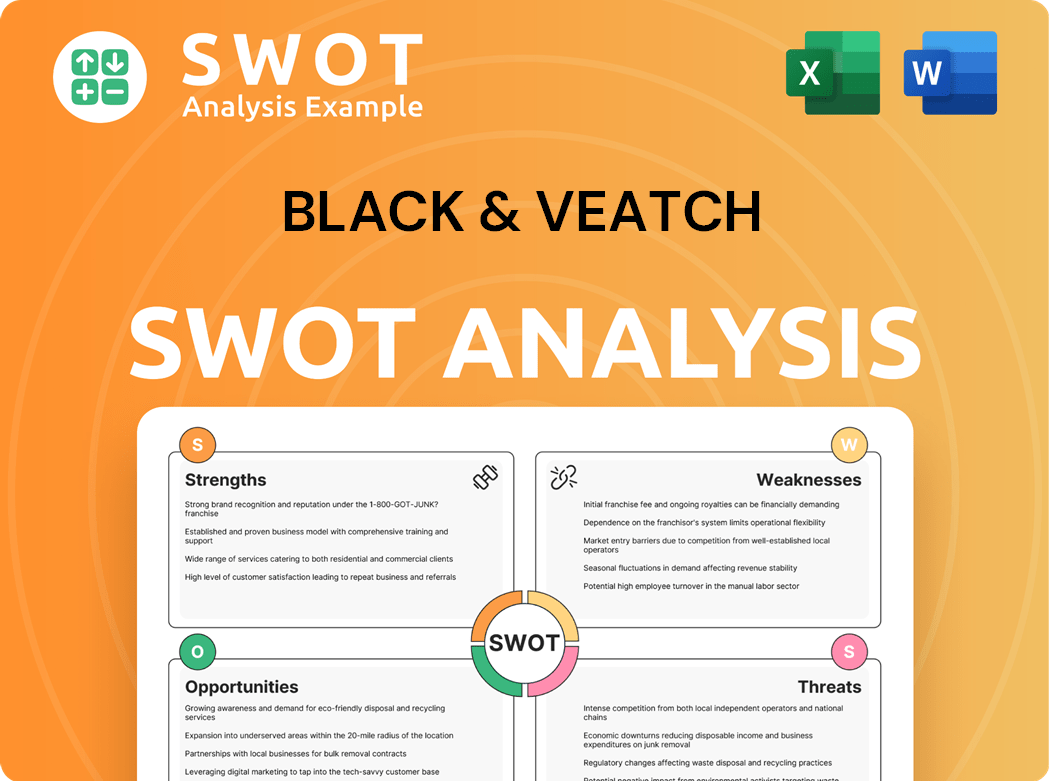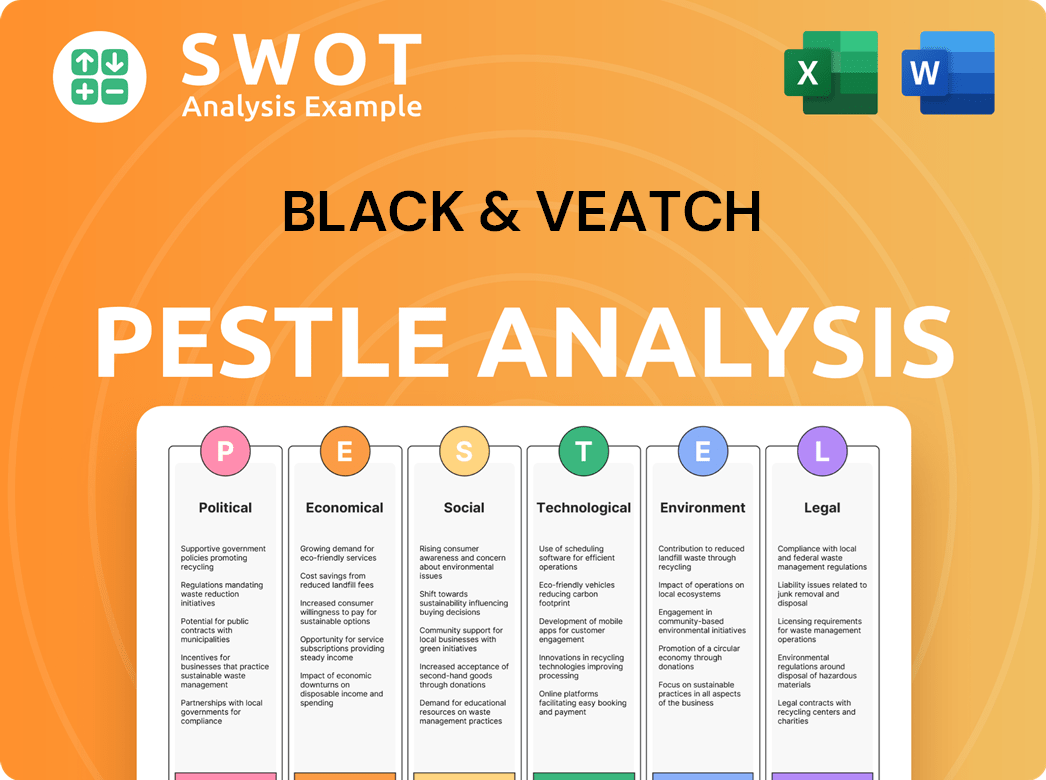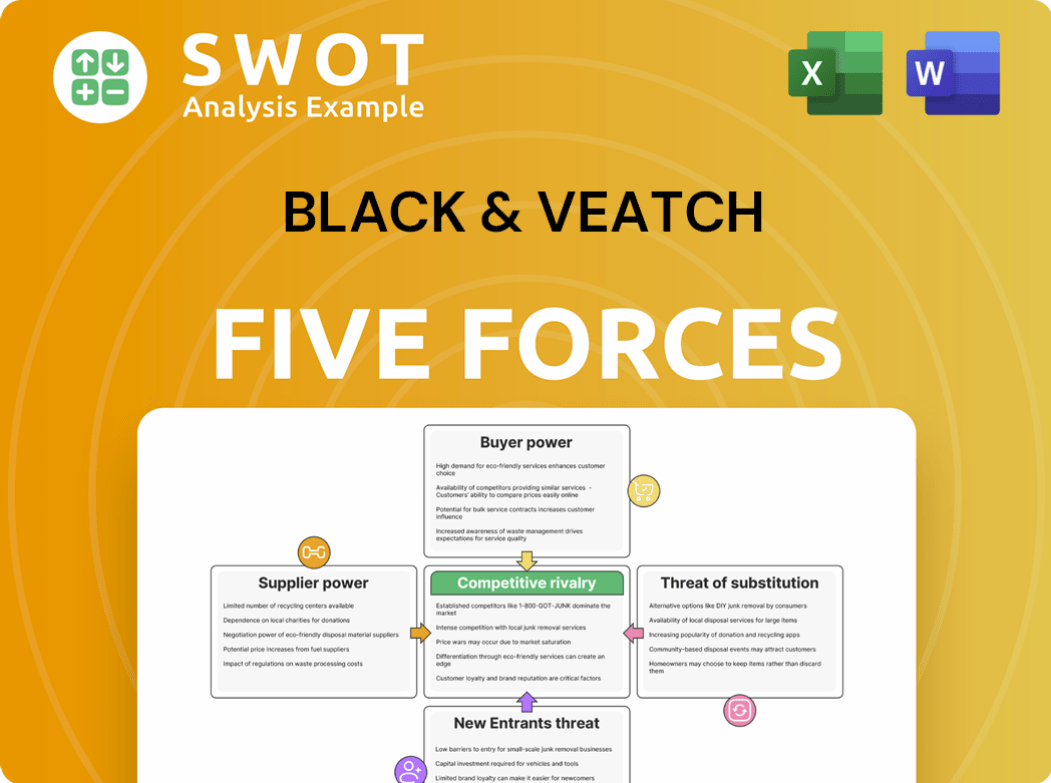Black & Veatch Bundle
Who Really Owns Black & Veatch?
Uncover the core of a global infrastructure giant: Black & Veatch. Understanding the ownership structure of any company is key to grasping its strategic direction and future potential. This is especially true for a firm like Black & Veatch, a leader in essential services. Delve into the unique ownership model that shapes its operations and influences its impact on the world.

Unlike many of its competitors, Black & Veatch operates under a unique employee-owned structure, a critical aspect of its Black & Veatch SWOT Analysis. This ownership model significantly impacts the company's culture, strategic decisions, and long-term vision. Exploring the evolution of Black & Veatch ownership reveals a fascinating story of how a company's structure shapes its success and commitment to its employees and clients. Learn about the Black & Veatch company profile and how it is organized.
Who Founded Black & Veatch?
The story of Black & Veatch's ownership begins in 1915 with its founders, Ernest Bateman Black and Nathan Thomas Veatch. Their partnership marked the inception of a firm built on engineering expertise and a commitment to client service. The initial structure was a straightforward partnership between these two individuals.
Ernest Black's engineering background and Nathan Veatch's focus on water and wastewater systems set the stage for the company's early projects. This collaboration formed the basis for the firm's early focus on public works and utility projects. The company's ownership was thus intrinsically tied to its founders' direct involvement and leadership.
The initial ownership of Black & Veatch was a partnership between Ernest Black and Nathan Veatch. Details of equity splits or initial shareholding percentages are not publicly available. The founders' vision for a client-centric engineering firm was directly reflected in their hands-on approach to management and project execution, establishing the foundation for its future growth.
Ernest Bateman Black and Nathan Thomas Veatch founded the company in 1915. They brought complementary skills to the table, engineering and water/wastewater expertise respectively.
The initial ownership was a partnership. Specific equity splits are not publicly detailed. The focus was on their contributions and responsibilities.
The company's early focus was on public works and utility projects. This reflected the founders' combined expertise. Their vision was client-centric.
Black & Veatch operated as a private partnership in its early stages. There is no public information on early investors. This structure was typical for professional service firms.
The founders' hands-on approach laid the foundation for future growth. This approach established the company's client-centric values. It set the stage for the transition to an employee-owned model.
The company's beginnings were shaped by its founders. Their expertise and commitment to service were critical. The early structure was a partnership.
The initial ownership of Black & Veatch, as a private partnership, was solely vested in its founders. The company's history, as detailed in a Brief History of Black & Veatch, highlights the significance of this early structure. This structure allowed the founders to directly shape the company's values and operational approach. This early phase was crucial for establishing the company's core principles. The company's revenue in 2023 was approximately $3.7 billion, a testament to its growth from its partnership beginnings.
The early ownership of Black & Veatch was a partnership between the founders, Ernest Black and Nathan Veatch.
- The founders' expertise in engineering and water/wastewater systems formed the basis of the company.
- The company's initial focus was on public works and utility projects.
- The private partnership structure allowed the founders to directly manage and shape the company.
- This early structure was crucial for establishing the company's core principles.
Black & Veatch SWOT Analysis
- Complete SWOT Breakdown
- Fully Customizable
- Editable in Excel & Word
- Professional Formatting
- Investor-Ready Format

How Has Black & Veatch’s Ownership Changed Over Time?
The evolution of Black & Veatch's ownership is a key aspect of its company profile. It transitioned from its initial structure to become an employee-owned entity. This shift began in 1956 with the establishment of an employee stock ownership plan (ESOP), marking a significant change in its corporate structure. This ESOP has been instrumental in shaping the company's trajectory over the years.
The employee ownership model has been pivotal in shaping the company's strategy. It has fostered a long-term perspective and prioritized client relationships and project quality. This is a departure from the short-term financial gains often associated with publicly traded companies. The ESOP structure ensures that the major stakeholders are the employees themselves, who accumulate shares over time. This structure has contributed to the company's stability and focus on sustainable growth.
| Year | Key Event | Impact on Ownership |
|---|---|---|
| 1956 | Establishment of the Employee Stock Ownership Plan (ESOP) | Initiated the transition to employee ownership. |
| Ongoing | ESOP Growth and Development | Increased employee ownership stakes, reinforcing the employee-owned model. |
| 2023 | Revenue of $4.3 billion | Demonstrates the operational scale under the employee ownership model. |
As of 2024, Black & Veatch remains employee-owned, with no external institutional investors or private equity firms holding major stakes. The company's structure prioritizes reinvestment of profits or distribution to employees through their ownership accounts. This approach has allowed Black & Veatch to maintain a focus on its core values and long-term strategic goals. The company's employee ownership model has significantly shaped its approach to projects and client relationships.
Black & Veatch is an employee-owned company, a unique structure in the industry.
- Employee ownership fosters a long-term perspective.
- Profits are reinvested or distributed to employees.
- The company's 2023 revenue was $4.3 billion.
- This model prioritizes client relationships and project quality.
Black & Veatch PESTLE Analysis
- Covers All 6 PESTLE Categories
- No Research Needed – Save Hours of Work
- Built by Experts, Trusted by Consultants
- Instant Download, Ready to Use
- 100% Editable, Fully Customizable

Who Sits on Black & Veatch’s Board?
The Board of Directors at Black & Veatch is pivotal in governing its employee-owned structure. The board usually includes both executive leaders from within the company and independent directors. These directors are accountable to the employee-owners. Specific details about current board members and their affiliations are not always publicly available due to the company's private status. However, the board's composition is designed to represent the interests of the employee-owners. Understanding the Revenue Streams & Business Model of Black & Veatch is crucial when examining the company's structure.
The leadership team steers the company. While the exact names and affiliations of board members aren't always public, the board's structure is set to represent the interests of the employee-owners. This helps ensure decisions align with the collective goals of the workforce. The company’s employee ownership model is a key aspect of its identity, influencing its governance and strategic direction. The company's structure is designed to foster stability and a long-term focus.
| Aspect | Details | Relevance |
|---|---|---|
| Ownership | Employee-owned | Influences governance and decision-making. |
| Board Composition | Executive leaders and independent directors | Represents employee-owner interests. |
| Voting Rights | One-share-one-vote for employee-owners | Aligns decision-making with workforce interests. |
The voting structure at Black & Veatch is tied to its employee stock ownership plan. Employees gain voting power through their ownership stakes. This typically follows a 'one-share-one-vote' principle. As a private, employee-owned company, Black & Veatch is not subject to proxy battles or activist investor campaigns. This structure generally leads to a more stable governance environment focused on long-term strategic objectives. The focus remains on long-term goals rather than short-term shareholder demands. Information about Black & Veatch's financial information is not always publicly disclosed.
Black & Veatch operates under an employee-owned model, which significantly influences its governance. The Board of Directors is composed of executive leaders and independent directors, all accountable to the employee-owners. This structure promotes stability and long-term strategic focus.
- Employee ownership drives decision-making.
- The board represents employee interests.
- Stability and long-term focus are key.
- Black & Veatch's legal structure is employee-owned.
Black & Veatch Business Model Canvas
- Complete 9-Block Business Model Canvas
- Effortlessly Communicate Your Business Strategy
- Investor-Ready BMC Format
- 100% Editable and Customizable
- Clear and Structured Layout

What Recent Changes Have Shaped Black & Veatch’s Ownership Landscape?
Over the past few years, the ownership structure of Black & Veatch has remained consistent, with a continued emphasis on its employee-owned model. This commitment is a key aspect of its operational strategy, distinguishing it from many other companies. There have been no indications of significant changes such as share buybacks or plans for an initial public offering (IPO), which are typical for publicly traded companies. Instead, the focus has been on organic growth and strategic partnerships.
For example, in 2024, Black & Veatch announced collaborations to advance sustainable infrastructure solutions, strengthening its market position. This approach aligns with the company's long-term vision, prioritizing client value and employee engagement over short-term financial gains. This unique structure influences how the company operates, making it different from those driven by external shareholder pressures. Understanding the Growth Strategy of Black & Veatch gives insight into the company's direction.
| Aspect | Details | Implications |
|---|---|---|
| Ownership Structure | Employee-owned | Maintains focus on internal growth, employee engagement, and long-term sustainability. |
| Recent Developments | Strategic partnerships, focus on sustainable infrastructure. | Reinforces market position and commitment to long-term goals. |
| Future Outlook | Continued emphasis on employee ownership and internal growth. | Prioritizes client value and employee well-being over short-term financial gains. |
Industry trends often involve consolidation or increased institutional ownership. However, as a mature, employee-owned firm, Black & Veatch operates outside these norms. Its ownership structure inherently resists dilution by external investors. Leadership transitions are managed internally, ensuring continuity and a focus on developing talent within the employee-owner pool. This approach allows Black & Veatch to prioritize long-term sustainability and client value, setting it apart from companies driven by quarterly earnings reports or external shareholder pressures.
Black & Veatch's employee-owned structure fosters long-term focus and client-centric values. This model differs from typical corporate structures, ensuring stability. The ownership structure supports internal growth and employee development.
Collaborations, such as those in 2024, drive sustainable infrastructure solutions. These partnerships enhance Black & Veatch's market position. This strategy aligns with the company's commitment to long-term goals.
Leadership transitions are managed internally, ensuring continuity. This approach fosters employee development and internal talent. It maintains the company's values and long-term vision.
Black & Veatch operates outside typical industry ownership trends. This unique model resists external investor influence. The focus is on long-term sustainability and employee engagement.
Black & Veatch Porter's Five Forces Analysis
- Covers All 5 Competitive Forces in Detail
- Structured for Consultants, Students, and Founders
- 100% Editable in Microsoft Word & Excel
- Instant Digital Download – Use Immediately
- Compatible with Mac & PC – Fully Unlocked

Related Blogs
- What are Mission Vision & Core Values of Black & Veatch Company?
- What is Competitive Landscape of Black & Veatch Company?
- What is Growth Strategy and Future Prospects of Black & Veatch Company?
- How Does Black & Veatch Company Work?
- What is Sales and Marketing Strategy of Black & Veatch Company?
- What is Brief History of Black & Veatch Company?
- What is Customer Demographics and Target Market of Black & Veatch Company?
Disclaimer
All information, articles, and product details provided on this website are for general informational and educational purposes only. We do not claim any ownership over, nor do we intend to infringe upon, any trademarks, copyrights, logos, brand names, or other intellectual property mentioned or depicted on this site. Such intellectual property remains the property of its respective owners, and any references here are made solely for identification or informational purposes, without implying any affiliation, endorsement, or partnership.
We make no representations or warranties, express or implied, regarding the accuracy, completeness, or suitability of any content or products presented. Nothing on this website should be construed as legal, tax, investment, financial, medical, or other professional advice. In addition, no part of this site—including articles or product references—constitutes a solicitation, recommendation, endorsement, advertisement, or offer to buy or sell any securities, franchises, or other financial instruments, particularly in jurisdictions where such activity would be unlawful.
All content is of a general nature and may not address the specific circumstances of any individual or entity. It is not a substitute for professional advice or services. Any actions you take based on the information provided here are strictly at your own risk. You accept full responsibility for any decisions or outcomes arising from your use of this website and agree to release us from any liability in connection with your use of, or reliance upon, the content or products found herein.